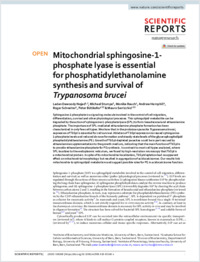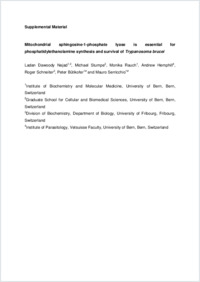Mitochondrial sphingosine-1-phosphate lyase is essential for phosphatidylethanolamine synthesis and survival of Trypanosoma brucei
- Dawoody Nejad, Ladan Institute of Biochemistry and Molecular Medicine, University of Bern, Bern, Switzerland - Graduate School for Cellular and Biomedical Sciences, University of Bern, Bern, Switzerland
- Stumpe, Michael Division of Biochemistry, Department of Biology, University of Fribourg, Fribourg, Switzerland
- Rauch, Monika Institute of Biochemistry and Molecular Medicine, University of Bern, Bern, Switzerland
- Hemphill, Andrew Institute of Parasitology, Vetsuisse Faculty, University of Bern, Bern, Switzerland.
- Schneiter, Roger Division of Biochemistry, Department of Biology, University of Fribourg, Fribourg, Switzerland
- Bütikofer, Peter Institute of Biochemistry and Molecular Medicine, University of Bern, Bern, Switzerland
- Serricchio, Mauro Institute of Biochemistry and Molecular Medicine, University of Bern, Bern, Switzerland
-
19.05.2020
Published in:
- Scientific Reports. - 2020, vol. 10, no. 1, p. 8268
English
Sphingosine-1-phosphate is a signaling molecule involved in the control of cell migration, differentiation, survival and other physiological processes. This sphingolipid metabolite can be degraded by the action of sphingosine-1-phosphate lyase (SPL) to form hexadecenal and ethanolamine phosphate. The importance of SPL-mediated ethanolamine phosphate formation has been characterized in only few cell types. We show that in the protozoan parasite Trypanosoma brucei, expression of TbSpl is essential for cell survival. Ablation of TbSpl expression increased sphingosine-1- phosphate levels and reduced de novo formation and steady-state levels of the glycerophospholipid phosphatidylethanolamine (PE). Growth of TbSpl-depleted parasites could be in part rescued by ethanolamine supplementation to the growth medium, indicating that the main function of TbSpl is to provide ethanolamine phosphate for PE synthesis. In contrast to most cell types analyzed, where SPL localizes to the endoplasmic reticulum, we found by high-resolution microscopy that TbSpl is a mitochondrial protein. In spite of its mitochondrial localization, TbSpl depletion had no apparent effect on mitochondrial morphology but resulted in aggregation of acidocalcisomes. Our results link mitochondria to sphingolipid metabolism and suggest possible roles for PE in acidocalcisome function.
- Faculty
- Faculté des sciences et de médecine
- Department
- Département de Biologie
- Language
-
- English
- Classification
- Biological sciences
- License
- License undefined
- Identifiers
-
- RERO DOC 328816
- DOI 10.1038/s41598-020-65248-x
- Persistent URL
- https://folia.unifr.ch/unifr/documents/308706
Other files
Statistics
Document views: 79
File downloads:
- sch_msp.pdf: 252
- sch_msp_sm.pdf: 136

